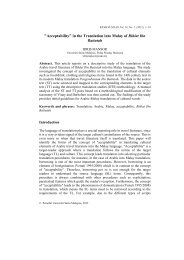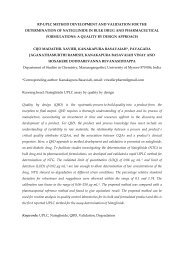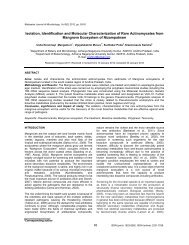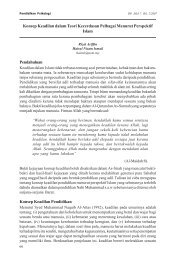45 Optimum conditions for uricase enzyme production by Gliomastix ...
45 Optimum conditions for uricase enzyme production by Gliomastix ...
45 Optimum conditions for uricase enzyme production by Gliomastix ...
You also want an ePaper? Increase the reach of your titles
YUMPU automatically turns print PDFs into web optimized ePapers that Google loves.
Mal. J. Microbiol. Vol 5(1) 2009, pp. <strong>45</strong>-50<br />
Aeration level<br />
It was economically important to examine the role of<br />
aeration level on <strong>uricase</strong> <strong>production</strong> in the fermentation<br />
medium. From the results recorded in Figure 3, it was<br />
observed that increasing aeration level was in favour of<br />
more <strong>uricase</strong> <strong>production</strong> and reached maximum (804.19<br />
U/mL) at 150 rpm, then decreased upon increasing the<br />
agitation speed (81.54 U/mL). Such finding was also<br />
obtained <strong>by</strong> Azab et al. (2005) who found that <strong>uricase</strong> was<br />
produced <strong>by</strong> Proteus vulgaris in submerged fermentation<br />
flasks on an incubator shaker at 180 rpm.<br />
Uricase activity (U/ml)<br />
900<br />
800<br />
700<br />
600<br />
500<br />
400<br />
300<br />
200<br />
100<br />
0<br />
0 100 150 200 250<br />
aeration level (rpm)<br />
Figure 3: Effect of different aeration levels on <strong>uricase</strong><br />
<strong>enzyme</strong> <strong>production</strong><br />
Carbon sources<br />
This experiment was designed to select the favorable<br />
carbon source <strong>for</strong> <strong>uricase</strong> <strong>production</strong>. The results in<br />
Figure 4 show that the highest amount of <strong>uricase</strong> <strong>enzyme</strong><br />
(1133.19 U/mL) was produced in the medium containing<br />
sucrose. These results were in agreement with those of<br />
Abd El Fattah and Abo Hamed (2002) who showed that A.<br />
flavus produced the highest amount of <strong>uricase</strong> in the<br />
medium containing sucrose.<br />
Nitrogen sources<br />
The present experiment was conducted to test the<br />
suitability of different nitrogen sources <strong>for</strong> <strong>uricase</strong><br />
<strong>production</strong>. The results presented in Figure 5 show that G.<br />
gueg (NRC1A) recorded highest amount of <strong>uricase</strong><br />
(1133.19 U/mL) when the fermentation medium contained<br />
uric acid. Similar results were obtained <strong>by</strong> other workers<br />
i.e. Yazdi et al. (2006) and Abd El Fattah and Abo Hamed<br />
(2002), who produced <strong>uricase</strong> in medium containing uric<br />
acid as a sole nitrogen source.<br />
Phosphours sources<br />
The results presented in Figure 6 show that dipotassium<br />
hydrogen phosphate gave the highest amount of <strong>uricase</strong><br />
(1133.19 U/mL). It was obvious that potassium phosphate<br />
is more suitable than sodium phosphate. These results<br />
48<br />
were disagree with those of Abd El Fattah et al. (2005)<br />
who found that KH2PO4 gave the highest amount of<br />
<strong>uricase</strong> as compared with K2HPO4. Hydrogen ion plays an<br />
important role <strong>for</strong> the acidic range balance.<br />
Uricase activity (U/ml)<br />
Uricase activity (U/ml)<br />
1200<br />
1000<br />
800<br />
600<br />
400<br />
200<br />
0<br />
1200<br />
1000<br />
800<br />
600<br />
400<br />
200<br />
Glucose<br />
0<br />
sodium nitrate<br />
Fructose<br />
potassium nitrate<br />
Lactose<br />
peptone<br />
Starch<br />
casein<br />
Sucrose<br />
Carbon sources<br />
uric acid<br />
Cellulose<br />
ammonium sulphate<br />
Glycerol<br />
Figure 4: Effect of different carbon sources on <strong>uricase</strong><br />
<strong>enzyme</strong> <strong>production</strong><br />
ammonium chloride<br />
Nitrogen sources<br />
Figure 5: Effect of different nitrogen sources on <strong>uricase</strong><br />
<strong>enzyme</strong> <strong>production</strong><br />
Incubation period<br />
The goal of this experiment was to select the optimum<br />
incubation period <strong>for</strong> <strong>uricase</strong> <strong>production</strong> <strong>by</strong> G. gueg<br />
(NRC1A) when grown on uric acid medium at 30 °C under<br />
shaken <strong>conditions</strong> <strong>for</strong> different periods of time. Results in<br />
Table 3 indicated that 8 days incubation was optimum <strong>for</strong><br />
<strong>uricase</strong> <strong>production</strong> <strong>by</strong> G. gueg (NRC1A). These results<br />
disagree with those of Abd El Fattah and Abo Hamed<br />
(2002) who produced <strong>uricase</strong> from A. flavus, Aspergillus<br />
terreus after 4 days incubation and from Trichoderma sp.<br />
after 6 days. Yukiko et al. (1976) produced maximum<br />
<strong>uricase</strong> <strong>by</strong> Hyphomyces after 5 days incubation.




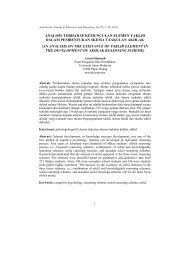
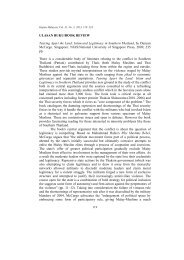

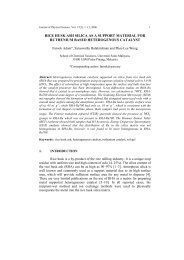

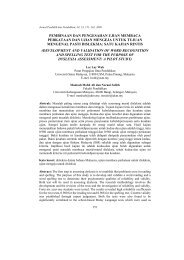
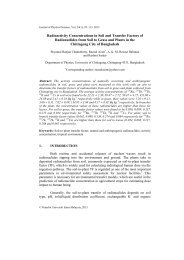
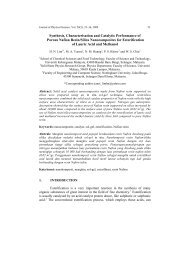

![KTT 111 – Inorganic Chemistry I [Kimia Takorganik I] - USM](https://img.yumpu.com/12405642/1/184x260/ktt-111-inorganic-chemistry-i-kimia-takorganik-i-usm.jpg?quality=85)
